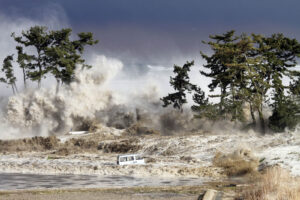A news article written by Shiela Poole of the Atlanta Journal-Constitution about an Archbishop saying no to religious exemptions to the COVID-19 caught my eye:
“There has been a great deal of hesitancy about getting the vaccine among many in Georgia (Atlanta), which has seen an alarming uptick in hospitalizations, largely from people who are unvaccinated.
The tsunami of the sick, fueled by the highly-contagious delta variant, has taxed the state’s health care system and hospital staffs.” I got ‘distracted’ by the clever and different use of ‘tsunami’ in the sentence; why? Well, a tsunami is a series of enormous waves usually started by earthquakes below or near the ocean. They can also be caused by volcanic eruptions, submarine landslides, and coastal rock falls, or even a large asteroid. How Ms. Poole creatively used ‘tsunami’ to emphasise the rise in numbers of people who are sick as a result of COVID-19 was very different, I thought.

Then it hit me; tsunamis are natural disasters that leave in their wake, destroyed properties and lives. Friday November 5 was (UN)World Tsunami Day (WTD) and it set my mind wondering about this different form of ‘pandemic’ that ravages countries lying along the rim of the Pacific Ocean. The largest and best-known ‘Pacific Rim’ countries are China, Australia, and South Korea. The United States, Canada, and Mexico all have Pacific Ocean coastlines and can be considered part of the region.
Background: The word ‘tsunami’ combines the Japanese words ‘tsu’ (harbour) and ‘nami’ (wave). They can’t be predicted, and often come with very little warning. The first sign of a tsunami is that the ocean begins to retreat, then the waves come crashing back – up to 30 metres high and travelling more than 800 kilometres per hour. More than 70 percent of all tsunamis ever recorded have been in the Pacific Ocean around the earthquake-prone “Pacific Ring of Fire” (which is the path along the Pacific Ocean characterized by active volcanoes and frequent earthquakes)
Take the Indian Ocean tsunami of December 2004, which caused an estimated 227,000 deaths in 14 countries. Caused by an underwater quake that was equivalent in power to 23,000 atomic bombs, it was the deadliest tsunami in recent decades. Indonesia, Sri Lanka, India and Thailand were the hardest hit.
In December 2015, UN General Assembly decided to dedicate 5th November as World Tsunami Day for taking specific preventive steps. This year marks the 6th edition of the observation of the day.
Tsunamis are one of the rarest and deadliest natural hazards that leave behind massive wrecks. They have no borders so international cooperation is key for better public and political understanding of undertaking measures to prevent risk. Japan came up with the idea of this day first. The day of 5th November is chosen for honouring a real story of Japan.
Other facts about tsunamis
- Tsunamis are caused by the undersea earthquakes, leading to waves that cause disturbances in the oceans
- Tsunami waves can range from 10 feet of height to 100 feet of height.
- Local Tsunamis can occur within a few minutes after the undersea disturbances. And they do not consider any time, weather, or season.
- Deadliest Tsunami attacks occurred in India on 26th December 2004, resulting in the highest number of deaths.
- Tsunami waves can rise to varying heights and travel at a higher speed of up to 800 km/hour, destroying everything coming in its path.
- Globally, Tsunamis account for a 10% loss in the economies, thereby setting development back in the risk-prone nations’ list.
- Over the last ten decades, 58 devastating Tsunami incidents occurred globally, resulting in an average loss of 2.6 lac lives with each disaster.
- Currently, over 700 million people live in low-lying coastal areas and small islands. According to the United States, it is estimated that around 50 per cent of the world’s population will live in coastal areas by the year 2030. They may be exposed to extreme sea-level events including flooding and tsunamis.
- The date of 5 November was chosen to commemorate the Japanese story of “Inamura-no-hi” (meaning “burning of the rice sheaves”). During an earthquake in the mid to late 1850s, a Japanese farmer saw the tide receding and knew a tsunami was about to hit. He set a fire to warn other villagers so they could flee to higher ground. Later, the farmer built an embankment and planted trees to protect the village from future tsunamis.
Interestingly, this year’s WTD theme “Leveraging the Power of Science and Technology to Reduce Tsunami Risk for Current and Future Generations” – how do you think you can be help?










